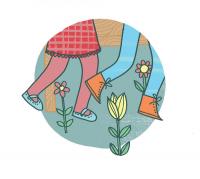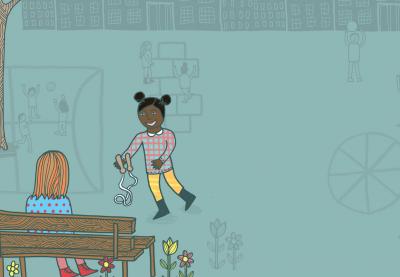At Vernfield Elementary, a school in the exurbs of Philadelphia, a first-grader named Brooke Sturm found herself alone at recess. So she sat on a bench next to the playground.
Two other first-graders, Kendal Hoover and Roisin McNamara, noticed her about a minute later. They ran across the play yard and invited Brooke to play tag.
“I just saw her, and she was my friend, and I wanted to play with her,” explained Kendal, age 6. She and Roisin knew what to do because Brooke was sitting on one of Vernfield’s two Buddy Benches, a playground installation where kids sit when they feel lonely, signaling other kids to ask them to play.
At least 1,000 elementary schools on six continents have installed Buddy Benches on their playgrounds. The popularity of Buddy Benches in the United States is credited to then-first-grader Christian Bucks, whose family was planning to move to Germany for his father’s job. When Christian was looking at German schools online, he saw a similar bench on one of its playgrounds. He liked the idea and shared it with the principal of his school, Roundtown Elementary in York, Pennsylvania. Christian’s family ultimately stayed in York, so after Christian started second grade in 2013, he introduced the Buddy Bench to his school during an assembly.
“Let’s say their best friend is absent. They can sit there,” explains Christian, now in fourth grade. “Kids are getting to know more people, and friends are being made.”
After a local newspaper published an article about Roundtown’s Buddy Bench, the story spread to media outlets like Today and The Huffington Post. Since then, the idea has spread through social media and word of mouth. Kids and educators at some schools have contacted Christian and his mother, Alyson Bucks, for advice. She maintains a website, Christian’s Buddy Bench, with a map of the benches she’s learned about through tools like Google News.
At Vernfield Elementary School, a parent saw one of those news stories after Vernfield merged with another school. Principal Jonathan Graf thought the benches would help students from the two schools connect.
“You don’t want any child in the school to feel disconnected from their school community,” Graf says.
The fifth-graders of the student body agreed and, in 2014, chose the benches as their class gift.
A Place for Every Child
When children feel excluded, “it’s painful, lonely and confusing,” says Ellen McCarty, who runs the Georgia operations of a nonprofit organization called Playworks. The group staffs low-income elementary schools with recess coaches who teach kids cooperative games, inviting all to participate and increasing their social emotional learning. The goals of Playworks and Buddy Benches are complementary: They aim to promote friendships and ensure every child has a place on the playground.
A Buddy Bench, by itself, can’t create a more positive place for kids. It must be part of a coordinated effort to create an inclusive school climate. Assessing the current status of a school’s culture is key to determining how to accomplish this goal, says consultant Nancy Mullin, director of Bullying Prevention Solutions.

“Schools that are trying to address bullying need to have a comprehensive plan,” she says. “The first step should be, ‘Let’s see what we’ve got going on here.’”
Educators should study incidents of bullying that have taken place and look for patterns, Mullin adds. Staff must consistently show they will always respond to and intervene with bullying.
Christian credits Roundtown’s counselor, Susan Landis, with helping make the school a welcoming place.
Landis says the school’s ability to be responsive is influenced by the Green Circle curriculum, which has three parts: caring, sharing and respect. Green Circle is referenced throughout the school year in lessons about how all people are different and how they may make friends differently too. The curriculum is used district wide.
Harbour View School in suburban Los Angeles has a Buddy Bench on its main playground and Buddy Chairs in its kindergarten play area. The idea came from a second-grader at Harbour View who learned about Roundtown’s bench. Principal Cindy Osterhout says the bench and chairs enhance the school’s use of Positive Behavioral Interventions and Supports, which emphasizes how to act respectfully rather than telling kids what not to do.
Educators who have used Buddy Benches effectively introduce the benches and their purpose during assemblies at the beginning of the year and continue to talk about the benches all year in conjunction with other efforts to promote a friendly school community. Each new student at Harbour View is paired with a fourth- or fifth-grader who helps the child collect stamps on a “passport.” Along with stops at the library and principal’s office, the tour includes sitting with the partner on the Buddy Bench during recess.
The website for Christian’s Buddy Bench suggests these rules.
Before you sit on the Buddy Bench, think of something you would like to do. Ask someone else to play with you.
The bench isn’t for socializing. Only sit there if you can’t find anyone to play with.
While you’re sitting on the bench, look around for a game you can join.
If you see something you want to do or a friend you want to talk to, get off the bench!
When you see someone on the bench, ask that person to play with you.
If you’re sitting on the bench, play with the first classmate who invites you.
Keep playing with your new friends!
A Child-Friendly Approach
While some might think sitting on the bench would invite bullying of a lonely child, kids at schools that have them say that doesn’t make sense.
“They just think it’s sad to not have anyone to play with,” says Zoey Ricigliano, a second-grader at Yardville Elementary in Trenton, New Jersey. “Our school isn’t just teaching us math and writing, but how to be nice.”
Students point out other benefits of having a Buddy Bench. Kids might be alone at recess because they’re in timeout for poor behavior, or they want some time to think. But a child on the bench clearly wants a friend.
In Pennsylvania, Graf speaks with students in terms of the Vernfield Vision, a mission statement that includes the line, “I will take care of other people, myself and my school.” He says Buddy Benches are another way to care for people.
“I think we’re doing a good job with them,” says fifth-grader Julia Vizza. “When I look over to them they’re usually empty.”
Tips for Bringing a Buddy Bench to Your School
Gather students’ ideas to make recess more inclusive.
Ask students how they think their peers would react to seeing a classmate sitting on a Buddy Bench. Would they be willing to sit on the bench themselves if they felt lonely?
Consult with teachers, staff and your school’s parent-teacher organization about introducing the concept of the Buddy Bench.
Involve students in a fundraiser to buy a bench for the school. Alternately, reach out to local builders or manufacturers who might be willing to donate a bench.
Get student input about where to place the bench. Invite them to design and paint it.
Work with your students to make rules for the Buddy Bench.
Recruit older kids to introduce the Buddy Bench to your students and help monitor its use.
Encourage families to talk about the Buddy Bench with their kids.

